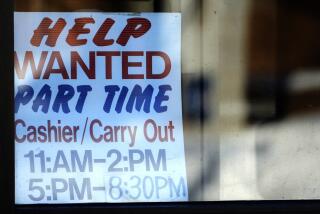Fewer Steps Up Available to Temps
- Share via
Temporary workers have the ladders to advancement kicked out from under them, a university sociologist contends.
“What we’re seeing is that firms have restructured in ways to permanently marginalize temporary workers,” said Martina Morris, a sociologist and statistician at Penn State University.
For these workers, “the internal job ladders are no longer there, and once they get into these temporary, short-term jobs they just churn from one of these jobs to another,” Morris said.
Her view was disputed by Bruce Steinberg, spokesman for the National Assn. of Temporary & Staffing Services, Alexandria, Va.
“Actually, I see it as temporary help can often offer job ladders where they did not previously exist in a permanent situation,” he said.
*
Economist Julie Hotchkiss of Georgia State University found that workers who take temporary jobs “may be better off in the long run because a transitional job will relieve enough financial pressure to give them the bargaining power to hold out for higher wages or a better job.”
According to Penn State’s Morris, temporary workers receive lower pay and benefits, and have fewer chances for promotion than regular company employees.
“The key question affecting employees is wage and career mobility, with core and peripheral workers being increasingly segmented in terms of salary and advancement potential,” she said.
It is “strategies within American companies themselves” that are creating “an increasingly unbridgeable gap in the U.S. labor force between haves and have-nots,” Morris claimed.
As more businesses lower costs by subcontracting noncritical tasks such as secretarial, data entry, and facilities management, Morris said, “they drive a wedge between workers in stable, well-paid core jobs and those in contingent, dead-end jobs.”
The Penn State sociologist compared labor market data for workers in the late 1960s and in the early 1980s, which she said enabled her to review changes in employment outcomes over time.
With senior research associate Annette Bernhardt, of Teachers College at Columbia University, she examined wage profiles, firm restructuring and labor market segmentation.
*
Between 1968 and 1987, much of the increase in part-time employment was “involuntary,” Morris said. The affected workers either were laid off or “could only find a job of this sort,” she said.
A classic example of jobs that have been shifted to outside contractors, she said, are the back office operations in Brooklyn and New Jersey of Manhattan’s big retail banks.
“You get a bunch of people on a phone bank handling customer service operations for credit cards, for example . . . who are completely segmented in terms of location from New York and whose chances for upward mobility are extremely small,” Morris said.
“Even their chances of moving laterally are made more difficult by their geographic isolation,” she added.
If present trends continue, Morris predicted, there will be “a decline in middle-class job holders and an increase in the percentage of the workers churning through various low-wage contingent jobs.”
A report published last year by the Economic Policy Institute in Washington, D.C., found that contingent, or temporary, workers earn $178 per week less than permanent workers and “generally have much lower access to health and other employer-provided benefits.”
“While 53.9% of non-contingent workers have health insurance through their employers, only 20.4% of contingent workers have such coverage,” the liberal nonprofit research organization reported.
More to Read
Inside the business of entertainment
The Wide Shot brings you news, analysis and insights on everything from streaming wars to production — and what it all means for the future.
You may occasionally receive promotional content from the Los Angeles Times.










